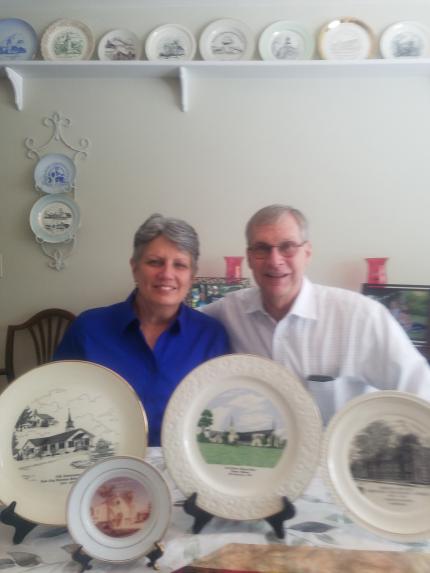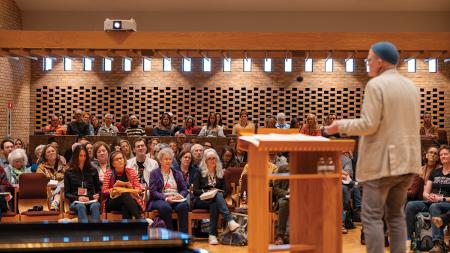Commemorative Church Plates Find a Home at CRCNA Office

Crys and Paul Van Beek
Chris Meehan
Crys and Paul Van Beek say their interest in collecting commemorative plates from Christian Reformed churches goes back many years, and now they have made a gift from their collection to the CRC office in Grand Rapids, Mich.
Years ago, say the Van Beeks, they were aware of how important a particular plate would be to certain people, and how some plates — usually marking important anniversaries — can be handed down from one generation to the next.
But that was about all they knew.
For example, some family members had given the Van Beeks a plate or two from churches that had special meaning to them. They appreciated hearing about the history of each church and what it meant to people.
Their interest grew memorably, however, on a day several years ago when they were driving back home from northern Michigan and spotted an antique store on the side of the road. They decided to stop.
As they browsed, they spoke to the shop owner. Finding they had some interests in common, the owner, a widow, said that her husband, a pastor, had collected church plates before he died, said Crys Van Beek. Seeing they were intrigued, the woman invited them into her home to see the plates.
They strolled through the home and found, to their surprise and delight, some plates from Christian Reformed churches. They bought a couple of the plates and brought them home. After that, said Crys, “We were on a roll.”
A buyers guide on ebay.com describes a tradition of commemorative plates and similar collectibles along these lines: “All types of dishware, particularly ones made from porcelain, were originally displayed in many noble homes around Europe for their beauty and rarity. Eventually, special events and other important people and places began to be featured on these plates. Many people started collecting these items and thus commemorative plates became all the rage throughout Europe and eventually the rest of the world” (see Your Guide to Buying Commemorative Plates).
In North America many denominations, including Methodists, Baptists, Lutherans, and African Methodist Episcopalians became keen on creating or ordering plates, often made of ceramic or porcelain, to celebrate milestone events.
For the Van Beeks, their commemorative plate hobby has led them to countless garage and yard sales, antique and second-hand stores, flea markets and fairs — and they have learned a lot in their research along the way.
“We became experts in church plates,” said Paul Van Beek, a retired accountant. “I even tracked down some plates by calling churches.”
Word got out about their interest in plates, and now friends and family members often give them plates that they have come across.
After collecting some 80 plates from churches across the denomination, the Van Beeks decided it was time to give up the quest. They looked around and talked about it and decided to donate most of them to the CRC’s denominational office in Grand Rapids, Mich.
“This was great news when they approached us,” said Jeff Bolt, director of advancement for the CRC Foundation and the Christian Reformed Church in North America.
“We already have quite of a few of their plates and have come up with a few different plans for them. The primary one is to have some bookshelves or plate hangers put up so that we can display them in the building.”
Arranged on a shelf in the Van Beeks’ dining room are a few of the plates that have yet to go to the denominational building. Starting at one end, Paul Van Beek pointed out a plate that shows a careful etching of Graafschap CRC in Holland, Mich., the first church in the denomination.
Then there is one from Franklin Street CRC in Grand Rapids, purchased at a garage sale.
These are followed by one from First CRC in Jenison, Mich., and one from First CRC in Sheldon, Iowa, near which Crys’s grandmother lived.
Also on the shelf were plates from Nobleford, Alta., and a plate from a CRC congregation in Volga, S.D., as well as one from a CRC in Manhattan, Mont.
The Van Beeks also have a treasured plate from Burton Heights CRC, their former church home in Grand Rapids until it closed in 2006.
“I was on the council before it closed, and we decided to have a plate made because the year we closed was the 100th anniversary” of Burton Heights CRC, said Paul Van Beek. “They told me we had to do this because they knew how interested we were in plates,” he added, and the church had about 100 commemorative plates made.
Another treasured item is a saucer from Redlands CRC, one of the first CRC congregations in California and the church home where Crys grew up.
They also have a plate from Fuller Ave. CRC in Grand Rapids, which is now their church home.
Some of the church plates include a short history of the congregation on the back; others have a Bible verse; others are blank. The Van Beeks commented that the draw of history, especially of the CRC of which they have been members all of their lives, is what kept them searching for the plates.
“These plates show the amount of interest that people have had in their churches,” said Crys Van Beek. “I think the plates are one way to show how the CRC has grown and [how congregations] have celebrated their history over the years.”


